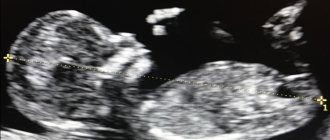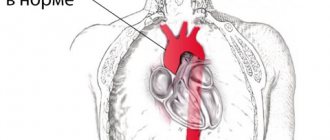The process of formation and development of the heart in an embryo
The formation of the heart and its development is one of the most complex processes occurring in the fetus’s body and mother’s abdomen. 2 weeks after fertilization, the process of heart formation begins. After another 2 weeks, a hollow, curved tube had already formed. At the 5th week of pregnancy, the first contractions of the tube occur, the intensity of which increases.
At week 5, using ultrasound, you can already see the rudiments of the heart. At this time, the formation of the heart continues, transverse and internal septa appear, thanks to which the organ becomes two-chambered. Gradually, the formation of longitudinal partitions occurs.
By week 9, the baby’s heart becomes an “adult”, having two atria, two ventricles, valves separating them and vessels to ensure blood flow.
However, the heart of the embryo has its own characteristics related to the supply of oxygen from the mother: between the atria there is an oval window, which is connected to the ductus arteriosus. After birth, this window closes and the ductus arteriosus collapses.
The process of heart development ends only by the 22nd week of pregnancy, then only an increase in its muscle mass and growth of the entire blood supply system occurs.
The fetal heartbeat is monitored using ultrasound (US), cardiotocography (CTG), auscultation (listening with a special tube) and echocardiography (EchoCG).
When does a fetus's heart begin to beat?
The development of your baby during pregnancy, from the moment of fusion of male and female reproductive cells to the birth of the child, is a small but real miracle. The beating of a tiny heart, which can be heard using ultrasound already in the early stages of pregnancy, clearly indicates: a new life is already real, in the mother’s belly there is not just an embryo, but a little person...
Intrauterine development of the human heart
Your baby develops from just one cell - the zygote, but the number of embryonic cells increases at an incredible rate. The formation of the circulatory system is the primary task of a small organism, because it needs oxygen supplied by blood.
- In the second week of development (4th obstetric week of pregnancy), when the size of the embryo is still less than 1 mm, its cells begin to divide into three “germ layers”, the middle of which later forms the circulatory system, kidneys, muscles, bones and cartilage.
- The third week of the baby’s life (5th obstetric week of pregnancy) is marked by the formation of a hollow vascular tube entangling his body - this is the primary blood circulation, which will later turn into the heart.
- On the 22nd day of development, the first contraction occurs in the curved part of the loop of the germinal circle of blood circulation, which is not yet controlled by the nervous system.
Heartbeat monitoring using ultrasound
So, when is a fetal heartbeat visible on an ultrasound? Since the first contractions occur already in the fifth or sixth weeks of pregnancy, the first beats can be heard using ultrasound.
To do this, use a special sensor that is inserted into the vagina. Using a sensor with which the doctor examines the fetus through the abdomen, the heartbeat is heard in the seventh week.
Each stage of pregnancy has its own heart rate:
- Between the sixth and eighth weeks, the fetal heart beats 110-130 times per minute.
- In the ninth and tenth weeks, the heart rate is 170-190 beats.
- Starting from the eleventh week and until birth, the baby’s heart in the womb makes 140-160 beats per minute.
The difference in indicators is affected by the process of formation and development of the fetal nervous system.
With the help of ultrasound examination of the fetal heart, not only the number of contractions is monitored, but also its location, size, nature of contractions, and their rhythm.
Characteristics
Throughout pregnancy, based on the characteristics of the fetal rhythm, it is possible, without interfering with the woman’s body, to monitor the development and physical condition of the child, notice violations in time and prescribe therapy.
Physical features of embryonic heart rate
Fetal heart rate is a variable value. The rhythm changes constantly: when the baby moves in the womb, during rest, after the mother eats, as a reaction to a drop in serum glucose.
Due to the characteristics of the embryo’s circulatory system at different stages of gestation, the heartbeat is determined by several factors:
- the stage of formation of the heart chambers;
- the presence of structural abnormalities;
- ingrowth of fibers of the autonomic nervous system into the myocardium;
- change in the fetal rest/activity cycle;
- maternal blood glucose level;
- the amount of hemoglobin in the blood;
- state of uteroplacental blood flow;
- the presence of umbilical cord compression;
- state of amniotic fluid;
- the general health of the mother.
Table of normal indicators at different periods
Fetal heart rate changes depending on the stage of pregnancy. Up to 9-10 weeks, the frequency progressively increases to 170-180/min, and then, by the 33rd week, it gradually stabilizes at around 140-160/min.
Table of fetal heart rate norms by week of pregnancy
| Gestational age (in weeks) | Average beats/min. | Variable fluctuations |
| 6 | 125 | 92—150 |
| 7 | 142 | 122—160 |
| 8 | 168 | 150—185 |
| 9 | 175 | 160—190 |
| 10 | 172 | 160—186 |
| 11 | 168 | 155—180 |
| 12 | 165 | 150—176 |
| 13 | 162 | 147—170 |
| 14 | 157 | 145—168 |
| 15—32 | 145 | 110—170 |
| 33—42 | 140—160 | 110—170 |
Some of my patients try to determine the sex of the unborn child using the fetal heart rate during the first ultrasound. They rely on the theory that a girl's heart beats at a frequency of 150-160 per minute, and a boy's - 140-150. But from the point of view of medicine, as well as my observations, the chances of guessing the gender in this way are 50%: the rhythm of the embryo is influenced by many factors, and not its gender. Moreover, these figures do not fit into the tabulated weekly fetal heart rate norms corresponding to the time of the first ultrasound screening.
Deviations from the norm
During ultrasound examination, there are cases of identifying deviations from the norm, which may be an indicator of deterioration in the condition of the fetus and its development process. So, deviations are considered:
- The number of beats per minute is less than 100.
- Increase in the number of heartbeats over 200.
- Complete absence of heartbeat.
During the first ultrasound, the doctor may not detect a fetal heartbeat. When its size exceeds 0.8 cm, there is a possibility of a non-developing pregnancy. However, this is not a definitive diagnosis. After five to seven days, a control ultrasound examination is performed, which confirms or refutes the diagnosis.
Also, the reason for the absence of heartbeat in the early stages may indicate a short period of time. After all, no one knows exactly when conception occurred and how many days the embryo is. It is necessary to undergo a re-test.
There is also a third reason for deviations in the number of heartbeats from the norm - the presence of pathological processes in the development of the internal organs of the embryo. To make such a diagnosis, the doctor examines the “four-chamber section.” An ultrasound image shows all four chambers of the heart at once. Ultrasound can detect more than 70% of heart defects. To clarify the diagnosis, echocardiography is performed.
Having discovered pathologies of the fetal cardiovascular system, doctors do not always suggest terminating the pregnancy. Today, surgery is well developed: highly qualified pediatric surgeons, high-tech equipment, innovative methods of treating pathologies of heart formation. The operation is carried out only with the consent of the parents and after a thorough examination. In practice, doctors have more than a dozen cases of saving babies born with heart defects.
In later stages, deviations from the norm depend on:
- Motor activity of the child.
- Physical activity of the mother.
- Presence of diseases during pregnancy.
How to listen to the fetal heartbeat
It is possible to assess fetal cardiac performance using:
- Ultrasound (in the early stages with an intravaginal sensor, then with a transabdominal one);
- cardiotocography (CTG);
- fetal Doppler;
- direct auscultation with a stethoscope.
Determination at home
Modern developments in the field of medical equipment offer portable devices that record fetal heart rate - fetal monitors.
This device allows you, regardless of time and place, to determine the baby’s cardiac activity or simply enjoy the sound of a beating heart.
The design of the Doppler is extremely simple:
- small-sized case with a digital display and buttons for sound control, recording and playback, which is powered by batteries;
- directly the sensor, which is connected to the base with a wire;
- headphones.
You can detect your heartbeat using a fetal monitor as early as the 12th week of pregnancy.
The cost of such devices in Russia is from 2 to 7 thousand rubles. More expensive models can transmit sound waves into the uterus. Manufacturers suggest playing slow music to calm a raging baby in the womb.
How to use a stethoscope and what it is
An obstetric (fetal) stethoscope is the simplest device for determining the functional state of a child and diagnosing fetal distress, available in every antenatal clinic.
Auscultation of the pregnant woman's abdomen is carried out from the second trimester during each visit to the obstetrician-gynecologist.
During auscultation of a pregnant woman’s abdomen with a stethoscope by an obstetrician-gynecologist, in addition to the baby’s heart sounds, the following can be heard:
- peristaltic sounds of the intestines and uterus;
- the sound of blood moving through the vessels of the umbilical cord;
- movements, fetal kicks;
- the beating of the abdominal aorta (must completely coincide with the pulse of the pregnant woman).
Reasons that make it difficult to listen to heart rate:
- significant fat layer of the anterior abdominal wall;
- attachment of the placenta to the anterior wall of the uterus;
- polyhydramnios.
Technique: the study is carried out when the pregnant woman lies on her back. Before listening, I determine the position, position, appearance and presentation of the fetus (its location in the uterus relative to the birth canal). This determines where to place the stethoscope. The heartbeat is best heard on the side of the fetal back, between its shoulder blades.
The fetal stethoscope is pressed with the wide end to the abdomen, and the other - tightly to the ear. The clarity and rhythm of heart sounds are determined, and the heart rate is calculated for 1 minute.
You can also listen to heart sounds using a standard phonendoscope.
Ultrasound
Ultrasound examination during pregnancy is an extremely important and reliable method for diagnosing fetal anomalies, monitoring its development, and determining delivery tactics.
This is a safe, fast, accessible and informative test for the mother and fetus, which does not require prior preparation (with the exception of a full bladder in early pregnancy).
Assessing fetal heart rate during ultrasound is most relevant before the second trimester. Next, the heartbeat is listened to with a stethoscope and CTG.
In addition to the rhythm, ultrasound examination at different stages of gestation determines:
- quantity, position and attachment of the fertilized egg;
- size, functional state of the placenta and umbilical cord;
- amount of amniotic fluid;
- size, weight of the child, presence of intrauterine developmental delay syndrome;
- position, position, appearance and presentation of the fetus (cephalic, pelvic, transverse, oblique);
- all internal organs are visualized, which allows early identification of various developmental anomalies and chromosomal pathologies;
- condition of the cervix.
Data obtained from an ultrasound examination, together with CTG, make it possible to determine the biophysical profile of the fetus - an integrated indicator that most accurately predicts the possible intrauterine death of the embryo.
Rice. Algorithm for assessing BPP.
Further tactics directly depend on the amount of points:
- 12-8 - normal condition of the fetus;
- 7-6 - questionable result (possible hypoxia), dynamic observation, daily CTG, counting movements, Doppler measurements of uteroplacental blood flow in dynamics;
- less than 5 - severe fetal distress, threat of antenatal death of the child, immediate delivery.
Cardiotocography: description of the method and its information content
CTG is a method of assessing the condition of a child through parallel recording of the baby’s heartbeat and contractile activity of the uterus. This is an accessible, non-invasive method for early diagnosis of fetoplacental circulatory disorders and monitoring of treatment.
The monitoring result is presented on a specially plotted sheet in the form of two curves. Modern cardiotocographs are equipped with the function of mechanical recording of fetal movements.
The autonomic innervation of the heart matures by the 32nd week of gestation. Therefore, acceleration (acceleration) and deceleration (deceleration) on CTG recorded before the third trimester can only be caused by the influence of the maternal body and intrauterine conditions on the sinoatrial node.
CTG recorded after the 32nd week reaches maximum diagnostic significance in assessing the functional state of the fetus. During this period, the myocardial reflex, sleep and wakefulness patterns mature.
The CTG procedure is carried out for at least 40 minutes, since it is necessary to examine the child’s cardiac activity during the period of his activity. The baby's sleep duration fluctuates in the range of 15-30 minutes, and during this period of time the indicators will coincide with those if his condition is disturbed.
CTG can be recorded in a lying or semi-sitting position. A sensor is attached to the pregnant woman's stomach in the projection of the fetal back (for twins - one for each child), and she is given a button in her hands, which she must press as soon as she feels the fetal movements (kicks, turns, stretching). This will help you better assess heart rate variability.
Based on the CTG results, the following are assessed:
- basal rhythm (averaged heart rate over 10 minutes of measurement);
- variability (the degree of deviation from the basal rhythm) - the number and amplitude of instantaneous oscillations are calculated;
- acceleration (heart rate acceleration by 15 beats/min or more for more than 15 seconds);
- decelerations (slowing down the rhythm) - types Dip1, 2, 3.
The obtained indicators are converted into points according to Fisher's criteria (Fig.).
Signs of a normal CTG:
- basal heart rate 110-150/min;
- variability 5-25 beats/min;
- no decelerations;
- more than 2 accelerations in 10 minutes.
If the above criteria are met for 20 minutes, the CTG is not recorded further.
Tactics for managing a pregnant woman depending on the number of points:
- 9-12 – satisfactory condition. There is no threat to the fetus.
- 6-8 - signs of fetal hypoxia. CTG registration is carried out daily.
- 0—5—severe fetal distress, threat of antenatal death. Urgent hospitalization and delivery.
If CTG results are questionable, functional tests are additionally performed to assess the reserve capabilities of the fetal circulatory system and increase the reliability of diagnosis.
- Non-stress test (NST). Tracking changes in the fetal heart rate in response to its own movements, thereby assessing the work of the myocardial reflex and, accordingly, the baby’s nervous system. Absence of heart rate response is an indication for an oxytocion test.
- Oxytocin contractile test. Monitoring the fetal heart response to uterine contractions.
- Sound stimulation test. Using a vibroacoustic system, the doctor wakes up a sleeping baby, thereby potentially increasing his activity and the information content of the study and reducing the frequency of false-positive CTG results.
But it is worth noting that cardiotocography registers disorders only at the time of recording, and the scoring system has a reliability of about 75%. To predict the outcome of pregnancy, these data can be used exclusively in combination with other diagnostic methods.
Heartbeat indicators and causes of deviations
When the heart rate is less than 120 per minute, this indicates: in the first weeks, a short period of time, a period of more than 12 weeks of fetal hypoxia and possible compression by the umbilical cord.
The number of beats is more than 170. In the early stages, it indicates a placentation disorder, however, in most cases this is the norm. From the 12th week, this indicator is affected by the motor activity of the fetus and mother, stressful situations of the mother and hypoxia. During labor, it indicates contraction or hypoxia.
When heartbeat sounds are difficult to hear: in the early stages, this indicates a short period of time, old equipment, excess weight in the mother, or heart defects. Muffled tones, starting from the 12th week, are a sign of: maternal obesity, placental insufficiency, presentation, high or low water, uncomfortable fetal position for examination or defects of the cardiovascular system.
During childbirth, dull sounds occur when contractions are active or the baby is starved of oxygen.
The absence of heart contractions indicates a short term, frozen pregnancy and spontaneous incipient abortion. At 12 weeks and during labor, the cause of this may be fetal death or incorrect examination.
The fetal heart goes through a difficult stage of formation, which is carefully examined by doctors at every appointment with the pregnant woman. When you can hear the fetal heartbeat on an ultrasound depends on the timing, quality of the equipment and the absence of pathologies.
Ultrasound indicators in early pregnancy
Ultrasound examination has become an integral part of obstetrics and it is difficult to imagine pregnancy management without this important examination method. But with the growing popularity of ultrasound, problems arose: it began to be abused, and the more and more often ultrasound is performed, the more the practical value of this examination method is lost. The quality training of ultrasound technologists and ultrasound doctors specializing in obstetrics, that is, diseases and abnormalities of the fetus (ultrasound perinatologists), still suffers. There are not enough such specialists all over the world. Interpretation of examination results is often difficult due to differences in reference values in different medical institutions, as well as in different countries.
Not long ago, a study was conducted in Canada to evaluate the accuracy of measuring the thickness of the placenta, and it turned out that the measurement error by different doctors of the same medical institution was 1-3 cm, and among European doctors these discrepancies were even greater. The human factor plays an extremely important role in the implementation of examinations, but so far the improvement of the level of training of medical personnel has been slow and ineffective.
Although most pregnant women trust their doctors, more and more often they have to double-check the results of the examination and the rationality of the prescribed treatment. In post-Soviet countries, many ultrasound specialists intervene in the pregnancy management process, giving recommendations and even prescribing treatment, which is not practiced in most countries of the world. The worst option is when the conclusion completely contradicts the measurements of fetal size and other pregnancy parameters. Many ultrasound doctors practice creating a diagnosis “out of nothing”: against the background of normal indicators, fictitious diagnoses of some disorders are made in the conclusion. A number of diagnoses are not recognized at all in modern obstetrics, for example, “uterine hypertonicity.” Therefore, having received a “terrible conclusion” and a negative prognosis if they refuse treatment (usually with a variety of ineffective bullshit drugs), many pregnant women dive into the Internet in search of ultrasound examination data in order to compare their results with those on the Internet. The most common question that comes up in such cases is: “How dangerous is this and will I be able to carry the pregnancy to term?”
The work of ultrasound specialists is now simplified by the fact that many indicators are compared with reference values automatically - through programs embedded in ultrasound machines. The task of the ultrasound specialist is to take measurements correctly and accurately. Because the fetus is small, especially in early pregnancy, the process of measuring different parts of the gestational sac and fetus can be difficult. A small error of just 1 mm can create a stressful situation when interpreting indicators and choosing pregnancy management tactics. In addition, we should not forget that many reference values were obtained based on data from small clinical studies several decades ago, at the dawn of the use of ultrasound in obstetrics. Therefore, a review of the indicators of norms and deviations is now underway, taking into account physiological changes in the progressing pregnancy and the growing fetus, depending on the period.
However, many pregnant women need accurate information to help them evaluate ultrasound results without the help of a doctor. Women often ask which type of ultrasound is better to perform: a transvaginal (TV) vaginal probe or a transabdominal (TA) probe for the abdomen ? There is no difference in choosing a sensor - it all depends on the doctor’s skills and his ability to take measurements correctly. As pregnancy progresses, a combination of sensors is used if necessary.
Another mistake made by doctors and pregnant women is constantly observed when calculating the duration of pregnancy. Remember: there is one type of gestational age - obstetric, and it is always expressed in weeks and days , not months. Sometimes, especially in the first weeks of pregnancy, it is called the menstrual period. There is no embryonic period! Ultrasound specialists are mistaken when they tell women that the period is determined by the size of the embryo, which means that it allegedly differs from the menstrual period (based on the first day of the last menstruation with regular menstrual cycles of 26–30 days). Any ultrasound machine calculates the due date, adjusted for the duration of menstruation and the size of the fertilized egg and embryo, and this is always the obstetric due date. The date of expected birth is also calculated based on the obstetric gestational age.
Ultrasound in the first trimester is performed for the purpose of:
- confirmation of intrauterine pregnancy;
- confirmation of live or frozen pregnancy;
- confirmation or exclusion of ectopic pregnancy;
- determining the duration of pregnancy;
- as part of prenatal genetic screening.
There are three phases of pregnancy, which can and should be monitored using an ultrasound picture of the stages of development of the fertilized egg, embryo and fetus.
- The conception phase, or concept, is the first 3-5 weeks. It begins from the moment of conception - approximately 2 weeks from the first day of the last menstruation - and the appearance of the fertilized egg, which cannot always be detected by ultrasound during this period.
- The embryonic phase is 6–10 weeks, when the embryo can already be detected.
- The fetal phase is from 10–12 weeks, when the embryo becomes a fetus and the process of formation and initial development of all organs and organ systems is completed.
Basic ultrasound parameters of normal pregnancy in the first trimester
Early pregnancy is confirmed by the presence of three important structural units:
- fertilized egg;
- yolk sac;
- fetal (or embryonic) pole.
Additional signs of intrauterine pregnancy: detection of a double decidual sac and a double vesicle symptom (ultrasound terms that people without medical education may not remember, but which are important to focus on when performing an ultrasound in the early stages).
Fertilized egg, or gestational (fetal) sac (GM)
The presence of a fetal sac is the first ultrasound sign of pregnancy. Until 5 weeks of pregnancy (from the last day of menstruation), it is most often not possible to see the presence of an embryo in the fertilized egg. By determining the size of the fetal sac, the gestational age can be determined with an accuracy of 1 week (+/-1 week). Once an embryo is detected, the size of the fertilized egg has no practical significance for determining the duration of pregnancy.
In obstetrics, two indicators are used to determine the duration of pregnancy by measuring the size of the ovum:
1) diameter of the gestational sac - only one measurement is taken;
2) average diameter of the gestational sac - determine the internal diameter of the ovum in three dimensions and calculate the average.
The fertilized egg can be seen in:
- 4 weeks and 3 days from the first day of the last menstrual period on TV ultrasound, and its diameter is usually 2–3 mm;
- 5–6 weeks from the first day of the last menstruation with TA ultrasound, and its diameter is about 5 mm.
Calculation of term based on the size of the fertilized egg:
Menstrual gestational age = Average diameter of gestational sac (mm) + 30 or 35 (if diameter less than 16 mm)
For example, the average diameter is 5 mm, gestation period = 5 + 30 = 35 days, or 5 weeks.
Normal growth rate
The ovum grows on average by 2 mm every 2 days from the 4th to the 9th week of pregnancy, but such indicators are usually not used to determine the progress of pregnancy, but are used only to confirm the diagnosis of its regression (fading).
What to look for
If the embryo cannot be detected when the fetal egg is 16–24 mm in size, it is necessary to suspect a frozen pregnancy or an empty fertilized egg and repeat the ultrasound in a week.
The size of the fertilized egg is greater than 25 mm and the absence of an embryo speaks in favor of a pathological pregnancy (frozen, empty fertilized egg).
If the size of the ovum decreases in the presence of a living embryo after 9 weeks, oligohydramnios can be suspected, although the level of amniotic fluid is usually determined no earlier than 18–20 weeks.
Yolk sac
Before the embryo appears, using ultrasound, you can see such an important structure of the fetal egg as the yolk sac. The yolk sac is 100% confirmation of the presence of intrauterine pregnancy. With an ectopic pregnancy, a formation can be found in the uterine cavity that is somewhat reminiscent of a fertilized egg, which is a specific reaction of the endometrium to pregnancy.
The yolk sac is located between the amnion and chorion (two formations of the fertilized egg from which the fetal membranes and placenta are formed) - in the chorionic space.
Normally, with an average diameter of the fertilized egg of 5 mm, the size of the yolk sac is up to 6 mm (on average - 3–5 mm). The maximum size of the yolk sac is observed at 10 weeks and is 5–6 mm. During the formation and development of embryonic organs, the yolk sac is partially used in the formation of the intestine.
Amnion
The amnion is the membrane (membrane) inside the fertilized egg that contains the fetus. The fetal membrane can be examined up to 12 weeks of pregnancy when the fetal size is 5–7 mm. The formation of the membranes is completed by 12–16 weeks.
Coccygeal-parietal size (KTP, CRL)
The coccyx-parietal size is the greatest length of the embryo, but significant errors are possible in measuring the size of the embryo. In the short term, when the limbs are poorly visible, it is more difficult to see the tailbone. By measuring this size of the embryo, you can set a more specific gestational age - with an accuracy of up to 4 days.
Using ultrasound, an embryo measuring 1–2 mm can be seen with a ovum measuring 5–12 mm at 5–6 weeks of pregnancy. During the day, the size of the embryo increases by 1 mm. A difference of 5 mm between the sizes of the embryo and fertilized egg is considered the minimum norm for pregnancy.
Calculation of gestational age
- Menstrual period in weeks = CTE (cm) + 6 (for CTE less than 1 cm)
- Menstrual period in weeks = CTE (cm) + 6.5 (if CTE is more than 1 cm)
- Menstrual period in days = CTE (mm) + 42 (with CTE up to 84 mm)
Fetal heartbeat
The heartbeat of the embryo/fetus can be detected at 6 weeks of pregnancy when the embryo is larger than 2 mm, which is a reliable sign of a live pregnancy. However, in embryos up to 5 mm (TV ultrasound) and 9 mm (TA ultrasound), the heartbeat may not be noticed, so in such cases it is advisable to repeat the ultrasound after 3-5 days.
Until 6 weeks of pregnancy, the fetal heart rate is 100–115 beats per minute. During weeks 6–9, the frequency increases and reaches a maximum of 144–159 beats per minute at 8 weeks. From 9 weeks the frequency decreases slowly and slightly.
A slowing of the heart rate is called bradycardia . However, it can also be a sign of fading pregnancy.
Bradycardia is diagnosed if:
- heart rate less than 80 per minute with CTE less than 5 mm;
- less than 100 beats per minute with CTE 5–9 mm;
- less than 110 beats per minute with a CTE of 10–15 mm.
Collar area (neck space, VZ, NT)
The collar zone is an accumulation of lymphatic fluid between the skin and soft tissues of the embryo behind the neck (in the collar area), the thickness of which is a prognostic indicator of fetal chromosomal abnormalities. It is measured at 11–14 weeks (up to 13 weeks 6 days) as part of first trimester prenatal genetic screening, which also includes the determination of biochemical markers in the mother's blood.
Since the size of the cervical fold depends on the size of the embryo, it is very important when measuring to stay within the limits of pregnancy - then the measurements will not only be accurate, but also have practical significance. That is, this is done with a CTE of 45–84 mm (11–14 weeks). Such a strict measurement framework is associated with the peculiarities of anatomical changes in the developing embryo, especially the lymphatic system and lymphatic fluid exchange.
The normal dimensions of the air intake are up to 3 mm. Sizes of 5 mm and more at 16–18 weeks, 6 mm and more at 19–24 weeks are considered pathological.
Unlike the nuchal translucency, which is measured in the first trimester, the thickness of the cervical band is measured in the second trimester . The cervical spine is the distance between the outer edge of the occipital bone and the skin of the fetal neck. In many cases of chromosomal abnormalities, especially those accompanied by malformations of the cardiovascular system, lymph metabolism is disrupted and it accumulates in the area of the cervical spine. Measurements are taken at 16–20 weeks (usually as part of an anatomical ultrasound), and measurements greater than 6 mm are abnormal.
Nasal bone
The presence or absence of a nasal bone, as well as its length, are recognized as markers for trisomy 21 (Down syndrome). Length is measured at 11–14 weeks as part of prenatal genetic screening. The absence of a bone or its length less than 2.5 mm may be signs of Down syndrome.
There are other ultrasound signs that are used by specialists to clarify the normal development of pregnancy or abnormalities, including frozen pregnancy, empty ovum and others.
Starting from the second trimester (after 14–16 weeks), all measurement indicators of certain parts of the fetus, as well as various indices that are calculated based on these indicators, are entered into graphs with initial percentile curves (95%, 50%, 5%), which were obtained through statistical processing of data from numerous fetal measurements in the past to determine normal growth and development indicators for a given fetus. Creating individual graphs of important ultrasound indicators allows you to see the child’s development over time and evaluate it more correctly.
For pregnant women, most of whom do not have a medical education, it is always important to know whether the gestational age according to ultrasound coincides with that expected by menstruation or the day of conception (not necessarily accurate to the day and hour), where the fertilized egg is located, including in relation to the walls uterus (fundus, posterior wall, anterior wall, internal os), how many fertilized eggs and embryos there are, whether the pregnancy is alive or has died out.
However, it is very important not to independently verify these results with data from numerous sites, because the lack of ability to correctly interpret this data will lead to false conclusions and unnecessary stress.
Remember: a healthy pregnancy does not require numerous ultrasounds and frequent monitoring!
Ultrasound as part of prenatal genetic screening - Dr. Elena Berezovskaya -
Routine ultrasound of pregnant women - Dr. Elena Berezovskaya -
Share link:
- Click to share on WhatsApp (Opens in new window)
- Click to share on Telegram (Opens in new window)
- Click here to share content on Facebook. (Opens in a new window)
- Click to share on Twitter (Opens in new window)
- Click to share on Skype (Opens in new window)
- Send this to a friend (Opens in new window)
- Click to print (Opens in new window)
By
How is an ultrasound performed at 6 weeks of pregnancy?
There are two options for how doctors do an ultrasound in the 6th week of pregnancy:
- The transvaginal method
is the insertion of a vaginal ultrasound sensor protected by a special condom into the vaginal cavity of a pregnant woman. - Transabdominal method
- through the skin of the abdomen. Before the scan, women apply a special gel to their abdomen.
The first method may cause some discomfort to the woman, but its results will be more accurate and complete. Contraindications to transvaginal ultrasound for a pregnant woman may include bleeding or abdominal pain.
What will an ultrasound show at 6 weeks of pregnancy?
What an ultrasound scan shows at the 6th week of pregnancy is very important, since it determines how the pregnancy will proceed in the future and whether its continuation is possible in principle.
Ultrasound at 6 weeks
shows:
- Is there a pregnancy?
- Location of the fertilized egg. The norm is the uterine location.
- Number of embryos. At the 6th week it will be possible to determine a multiple pregnancy.
- Dimensions of the fertilized egg. This indicator is necessary for doctors to clarify the gestational age.
- Fetal heartbeat. Only modern equipment can allow you to listen to the heart of an unborn baby at the 6th week. If the ultrasound machine does not have this capability, you will have to wait another 1-2 weeks to accurately assess the beating frequency of the small heart.
At the 6th week, it is too early to talk about identifying any developmental defects, since not a single system or organ in the fetus has yet formed.
If the embryo in the cavity of the ovum is not visualized, this may signal the fading of pregnancy (that is, the death of the fetus). After the ultrasound, you can take a photo in which the outlines of the future baby will be visible.
When should an ultrasound be performed for pregnant women?
To obtain more complete and comprehensive information, ultrasound is performed at certain stages of pregnancy, and such studies are called screenings. During the entire pregnancy period, any patient must undergo three ultrasound screenings:
I screening
11-14 weeks (ultrasound + biochemical screening for chromosomal pathologies)
II screening
18-22 weeks (ultrasound + Dopplerometry). You can already find out the gender of the baby!
III screening
30-34 weeks (ultrasound + Doppler ultrasound + cardiotocography)
Fetal development
From the moment of conception until the birth of the child, approximately 260–270 days pass.
The size of the embryo increases from a few millimeters to 45–60 cm. At this time, about 200 million cells develop. The intrauterine period of development can be divided into three main stages:
- A stage that begins from the time of fertilization and lasts until the embryo attaches to the wall of the uterus, which makes it possible to receive nutrition from the mother.
- Formation of all internal organs in the child. At this stage, the embryo takes on the shape of a human body.
- The final formation of the baby’s internal organs and life support systems. At the end of this period, the baby, who is in the vagina, can already exist independently, separately from the mother, and the beating of his heart can be clearly heard.
Experts have found that on days 6–7 after fertilization, the embryo begins to attach to the wall of the uterus. The duration of this period is only 48 hours. This is known as the implantation period. At this time, the embryo is completely embedded in the uterine mucosa.
There are two stages of implantation:
- Adhesion.
- Penetration.
The result of this period is the ability of the embryo to receive nutrition and oxygen from the mother's body.
At the end of 4 weeks, using modern equipment, you can already see an embryo whose length is only 5 mm. It is at this stage that an ultrasound examination can be used to confirm a woman’s pregnancy and determine its duration.
Cost of ultrasound during pregnancy
| Name of service | Price, rub.) |
| Primary appointment with a general practitioner | 1800 rub. |
| Repeated appointment with a general practitioner | 1300 rub. |
| Ultrasound - pregnancy up to 12 weeks | 2500 rub. |
| Ultrasound - pregnancy (long term) | 3000 rub. |
| Ultrasound 3D (without recording to disk) | 3500 rub. |
All our services and prices
Emergence of the embryo
It's no secret that at the moment of emergence, a person is just one egg fertilized by a sperm. We also know from the school curriculum that a fertilized cell moves to the uterus through the fallopian tube for up to five days, and from the first hours the cell begins to actively divide, so as a result, a multicellular organism arrives in the mucous membrane of the uterus, which is called an embryo. Subsequently, with normal development, the embryo grows into the uterus with its cells and actively develops for nine months.









